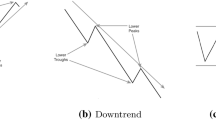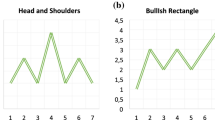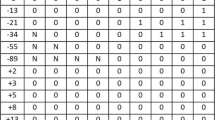Abstract
Throughout the years, numerous methods have been proposed for FOREX trading analysis and forecasting. As analysts/traders prefer to work with historical trading data, technical analysis based methods are often used. This paper presents an in-depth examination of technical analysis methods with an emphasis on charting/pattern-based analysis. Our findings indicate how to overcome the subjectivity often associated with identification and extraction of patterns within FOREX historical data. Based on historical facts that FOREX chart patterns repeat over time, the proposed method improves the approach towards identification of chart patterns as well as prediction of their recurrence regardless of the time warping effect affecting their formation.
Access this chapter
Tax calculation will be finalised at checkout
Purchases are for personal use only
Similar content being viewed by others
References
King, M.R., Mallo, C.: A user’s guide to the Triennial Central Bank Survey of foreign exchange market activity. BIS Q. Rev., 71–83 (2010)
Bank of International Settlements: Triennial Central Bank Survey - Foreign Exchange Turnover in April 2013: Preliminary Global Result (2013)
Schulmeister, S.: Components of the profitability of technical currency trading. Appl. Financ. Econ. 18(11), 917–930 (2008)
Neely, C.J., Weller, P.A.: Technical analysis in the foreign exchange market. Federal Reserve Bank of St. Louis Working Paper Series 2011-001B (2011)
Hsu, P.H., Taylor, M.P., Wang, Z.: Technical trading: is it still beating the foreign exchange market? J. Int. Econ. 102, 188–208 (2016)
Bagheri, A., Peyhani, H.M., Akbari, M.: Financial forecasting using ANFIS networks with quantum-behaved particle swarm optimization. Expert Syst. Appl. 41(14), 6235–6250 (2014)
Gerlein, E.A., McGinnity, M., Belatreche, A., Coleman, S.: Evaluating machine learning classification for financial trading: an empirical approach. Expert Syst. Appl. 54, 193–207 (2016)
Czekalski, P., Niezabitowski, M., Styblinski, R.: ANN for FOREX forecasting and trading. In: 20th International Conference on Control Systems and Computer Science (CSCS 2015), pp. 322–328 (2015)
Ozturk, M., Toroslu, I.H., Fidan, G.: Heuristic based trading system on Forex data using technical indicator rules. Appl. Soft Comput. 43, 170–186 (2016)
Forex indicators: The best guide to indicator’s world. http://forex-indicators.net/list
Gallo, C.: The forex market in practice: a computing approach for automated trading strategies. Int. J. Econ. Manag. Sci. 3(169), 1–9 (2014)
Bulkowski, T.N.: Encyclopedia of Chart Patterns, 2nd edn. Wiley, New York (2005)
Ito, T., Hashimoto, Y.: Intraday seasonality in activities of the foreign exchange markets: evidence from the electronic broking system. J. Jpn. Int. Econ. 20(4), 637–664 (2006)
Person, J.L.: A Complete Guide to Technical Trading Tactics: How to Profit Using Pivot Points, Candlesticks & Other Indicators. Wiley, New York (2004)
Talebi, H., Hoang, W., Gavrilova, M.L.: Multi-scale foreign exchange rates ensemble for classification of trends in forex market. Procedia Comput. Sci. 29, 2065–2075 (2014)
Muggeo, V.M.R.: Estimating regression models with unknown break-points. Stat. Med. 22(19), 3055–3071 (2003)
Wood, S.N.: Minimizing model fitting objectives that contain spurious local minima by bootstrap restarting. Biometrics 57(1), 240–244 (2001)
Author information
Authors and Affiliations
Corresponding author
Editor information
Editors and Affiliations
Rights and permissions
Copyright information
© 2017 Springer International Publishing AG
About this paper
Cite this paper
Yong, Y.L., Ngo, D.C.L., Lee, Y. (2017). Detection of Repetitive Forex Chart Patterns. In: Tan, Y., Takagi, H., Shi, Y., Niu, B. (eds) Advances in Swarm Intelligence. ICSI 2017. Lecture Notes in Computer Science(), vol 10386. Springer, Cham. https://doi.org/10.1007/978-3-319-61833-3_42
Download citation
DOI: https://doi.org/10.1007/978-3-319-61833-3_42
Published:
Publisher Name: Springer, Cham
Print ISBN: 978-3-319-61832-6
Online ISBN: 978-3-319-61833-3
eBook Packages: Computer ScienceComputer Science (R0)




